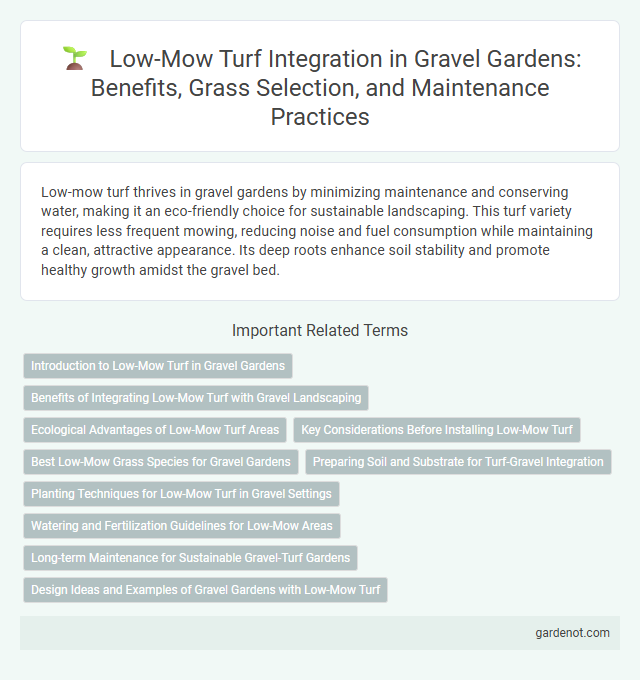Low-mow turf thrives in gravel gardens by minimizing maintenance and conserving water, making it an eco-friendly choice for sustainable landscaping. This turf variety requires less frequent mowing, reducing noise and fuel consumption while maintaining a clean, attractive appearance. Its deep roots enhance soil stability and promote healthy growth amidst the gravel bed.
Introduction to Low-Mow Turf in Gravel Gardens
Low-mow turf varieties such as fine fescues and buffalo grass offer an eco-friendly solution for gravel gardens by reducing maintenance and water consumption. These grasses thrive in well-drained gravel substrates, enhancing garden aesthetics with minimal mowing frequency, typically only a few times per season. Incorporating low-mow turf supports biodiversity and soil health, creating a sustainable and visually appealing gravel garden environment.
Benefits of Integrating Low-Mow Turf with Gravel Landscaping
Low-mow turf enhances gravel garden design by reducing maintenance needs and conserving water, promoting sustainability. Its resilient, drought-tolerant grass varieties complement the porous nature of gravel, improving soil health and preventing erosion. The integration creates an aesthetically pleasing, eco-friendly landscape that supports biodiversity and lowers lawn care costs.
Ecological Advantages of Low-Mow Turf Areas
Low-mow turf areas in gravel gardens reduce the need for frequent mowing, minimizing carbon emissions and fuel consumption while promoting habitat for pollinators and beneficial insects. These turf zones enhance soil health by encouraging deeper root growth, improving water infiltration and nutrient cycling in gravel garden ecosystems. Integrating low-mow turf supports biodiversity, contributing to sustainable landscape management and resilient urban green spaces.
Key Considerations Before Installing Low-Mow Turf
Low-mow turf requires careful evaluation of soil composition, drainage capacity, and local climate to ensure optimal growth and durability. Selecting drought-resistant, low-maintenance grass species reduces watering frequency and mowing efforts, aligning perfectly with gravel garden aesthetics. Proper installation involves thorough soil preparation and root zone aeration to prevent compaction and promote healthy turf establishment.
Best Low-Mow Grass Species for Gravel Gardens
Fine fescues, such as hard fescue and creeping red fescue, are among the best low-mow grass species for gravel gardens due to their drought tolerance and low maintenance requirements. Buffalograss also performs well in gravel settings, thriving in well-drained soils with minimal watering and infrequent mowing. These species create durable, attractive turf that complements the texture and drainage of gravel gardens while reducing upkeep.
Preparing Soil and Substrate for Turf-Gravel Integration
Preparing soil for low-mow turf in a gravel garden involves ensuring proper drainage and aeration to support healthy root growth beneath the gravel surface. Incorporating a well-balanced substrate mix with organic matter and sandy soil enhances moisture retention while preventing compaction. Optimal soil pH between 6.0 and 7.0 promotes nutrient availability, facilitating robust turf establishment within the gravel matrix.
Planting Techniques for Low-Mow Turf in Gravel Settings
Planting low-mow turf in gravel garden settings requires selecting drought-tolerant grass species such as fescues or buffalo grass that thrive with minimal watering and mowing. Preparing the soil with well-draining amendments and creating a graded base supports root development and prevents waterlogging. Strategic spacing and gradual integration of turf patches enhance soil stability and allow for natural gravel movement, maintaining the garden's aesthetic and ecological balance.
Watering and Fertilization Guidelines for Low-Mow Areas
Low-mow turf in gravel gardens requires deep, infrequent watering to promote drought-resistant root systems, ideally watering early in the morning to reduce evaporation. Fertilization should be minimal, using slow-release, low-nitrogen fertilizers to maintain turf health without encouraging excessive growth. Maintain proper soil aeration to support nutrient absorption and reduce the risk of fungal diseases in these low-maintenance landscapes.
Long-term Maintenance for Sustainable Gravel-Turf Gardens
Low-mow turf varieties significantly reduce the frequency of mowing needed in gravel garden landscapes, promoting sustainable maintenance practices. These grasses have deep root systems that enhance soil stability and moisture retention, minimizing irrigation requirements over time. Emphasizing slow-growing, drought-tolerant species supports long-term ecological balance while maintaining aesthetic appeal in gravel-turf garden designs.
Design Ideas and Examples of Gravel Gardens with Low-Mow Turf
Incorporating low-mow turf into gravel garden designs creates an attractive, low-maintenance landscape that balances texture and color. Examples include blending fine fescue or buffalo grass between gravel pathways and stone features to provide soft greenery without overwhelming the hardscape. Design ideas emphasize irregular turf patches to break gravel expanses, enhancing biodiversity while maintaining a sleek, modern aesthetic.
Low-mow turf Infographic

 gardenot.com
gardenot.com